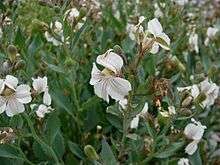Goodenia albiflora
Goodenia albiflora, commonly referred to as the white goodenia, is a rhizomatous herb native to the Adelaide region of southern Australia.[1]
| Goodenia albiflora | |
|---|---|
 | |
| Scientific classification | |
| Kingdom: | Plantae |
| Clade: | Tracheophytes |
| Clade: | Angiosperms |
| Clade: | Eudicots |
| Clade: | Asterids |
| Order: | Asterales |
| Family: | Goodeniaceae |
| Genus: | Goodenia |
| Species: | G. albiflora |
| Binomial name | |
| Goodenia albiflora | |
Leaves are a blue-green in colour and alternate up the stem. They range from 2-4 centimetres long, have prominent veins and serrations on the side, and have pointed tips. They are semi-succulent.
Spectacular masses of blue-white flowers form in spring and early summer. These are in the typical Goodenia hand shape, and are approximately 2 centimetres in diameter. These flowers make it an important food plant for native insects such as butterflies. Flowers are replaced by papery capsules containing several 5mm wide disc shaped seeds.
Goodenia albiflora is hard to grow from seed, but much easier from cuttings or rhizome sections. It prefers well drained, lime rich soils, and is a useful plant for steep slopes and cuttings because of its good soil binding properties.[2]
References
- "Plants of the Adelaide plains and hills". Library of South Australia. Retrieved 21 March 2011.
- "The Native Plants of Adelaide". Department for Environment and Heritage. Archived from the original on 15 March 2011. Retrieved 21 March 2011.